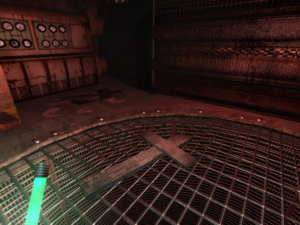Penumbra: Requiem
The third game of the Penumbra trilogy is actually an expansion pack for the second game. Various blurbs say that it “ties up loose ends” in the first two games, but really, the only loose end is what happens to Shelter (as the secret excavation site is called) after Philip’s messages go out, and it doesn’t even address that. I suppose there are probably players asking “What happened to Philip after the second game? How did he escape?” — to which the only sensible answers are “Exactly what you saw” and “He didn’t”. It’s a horror story. Seekers after forbidden knowledge have to pay a terrible price.
Nonetheless, Penumbra: Requiem follows Philip’s further adventures. Just one problem: none of it is real. I’ll avoid spoilers about the precise sort of unreality it is — certainly there are multiple possibilities within the previous game’s fiction — but the game doesn’t take long to start dropping hints of irrationality underlying the world, like in a Philip K. Dick novel. For example, at one point, the automatic PA-recording voice, previously heard issuing GLaDOS-like cheerful reminders about how all personnel are required to bring their cyanide capsules when on shift and suchlike, addresses Philip by name, and whispers advice clearly meant for you specifically. Later, it addresses you as “Player”. (Add Metal Gear Solid 2 to the list of games Penumbra has reminded me of!) It’s surreal, but it also lowers the stakes somewhat: how can you be worried about the effects of your actions in a world that makes no sense?
But then, the stakes are already low, because there are no monsters at all this time around. That means it can’t really be described as a survival-horror or a stealth game any more. (Crouching in darkness produces the now-familiar hiding-in-shadows screen effects, but there’s no one around to appreciate it.) Since there’s no need for places to hide in or flee through, the hub areas made of networks of corridors have been eliminated too. Instead, what we have left is a series of self-contained puzzle scenarios with no logical connections to each other: each segment ends with Philip going through a teleporter. So, it’s more purely a puzzle game than the previous installments — the only thing that breaks it up is the frequent platforming elements (including, at one point, a Donkey Kong homage).
Oddly enough for an adventure game, it doesn’t use the inventory for anything except your standard tools (flashlight, notebook, pain relievers, etc). There are things you need to carry around, but it’s always done by dragging them from place to place in the scene itself, like in Half-Life 2 and Portal. Those games built puzzles around this interface, but didn’t explore it as much as Requiem does, or show how well it works in an adventure context. I’d say it works pretty well, as long as the puzzles are designed for it. It feels more natural than an inventory menu, more like a unified interface of the sort found in Mystlike games, but provides a greater range of action than a pure Mystlike click-on-stuff interface. One key mechanic to support it is the way that objects that have to be put in a particular place (in a slot, say) are guided to that position automatically when you get them close enough. This provides important feedback, letting the player know that they’ve done something right.
I should talk about the light. All three games give you three ways of lighting up dark places: glowstick, flashlight, and flares. Overture had text suggesting that the flashlight was the best light source, but the ridiculous rate at which it chewed up batteries meant that you’d sometimes have to resort to the never-dying glowstick. I personally found that this was hogwash: the flashlight may have been better for lighting things at a distance, but since you can’t interact with distant things, the glowstick, with its 360-degree illumination, was more practical. Somehow, though, I found myself using the flashlight more in Black Plague. I’m not sure why. Maybe it was changed to illuminate immediate surroundings better, or maybe the levels just had more long, dark corridors. At any rate, the whole idea of conserving your light fits better with the survival-horror stuff than with a pure adventure game, so Requiem dropped it, and gave you a flashlight with infinite charge. I basically never turned it off.
I notice that I’m talking mostly about mechanics this time, whereas my posts about the previous ones are almost entirely about plot. That’s because there really isn’t much plot this time around. I’d guess that the authors were thinking that, because this is just an expansion pack and not a proper sequel, it can’t have any important plot developments. It’s like the Sunday episodes of syndicated comic strips: since not all newspapers have a Sunday edition, nothing can be allowed to happen that affects continuity. The mechanics, though, are top-notch.
 Comments(0)
Comments(0)